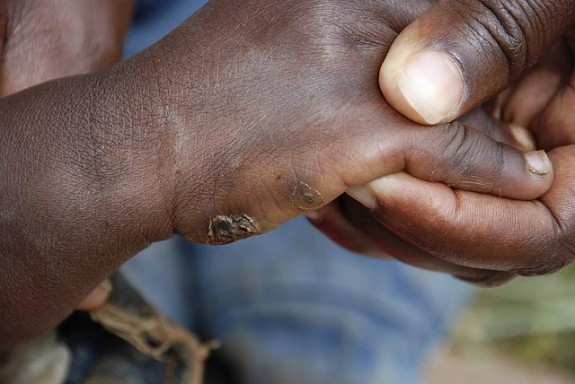This Scientist Let a Flea Live Inside Her In Order to Study It
To what lengths would you go for science?
/https://tf-cmsv2-smithsonianmag-media.s3.amazonaws.com/filer/2013111212002611_12_2013_chigoe-flea.jpg)

The early stages of a sand flea infection. Photo: Adele Booysen
The history of science is filled with stories of curious folks, who, for one reason or another, thought it would be a great idea to experiment on themselves: Benjamin Franklin with his lightning rod kite, Isaac Newton, stabbing himself in the eye with a needle to see what would happen, Jonas Salk, giving himself (and his family) his experimental polio vaccine. But these are tales of a bygone era, when curiosity took charge and basic lab safety standards hadn’t taken hold.
Or not.
From Science magazine, we learn the much more modern story of Marlene Thielecke, a budding medical researcher who decided to let a sand flea live in her foot. Why? She wanted to answer a question:
Where, exactly, does the sand flea have sex? On the dusty ground, where it spends the first half of its life? Or already nestled snugly in its host—such as in a human foot—where it can suck the blood it needs to nourish its eggs?
Thielcke was already researching a disease, known as tungiasis, which often results from a sand flea infection, says Geekosystem. But, scientists don’t really know how the critters reproduce. So, “upon discovering a flea living in her foot, Thielecke - instead of reacting with the appropriate terror response – decided to study the creature, in the hopes it might help science.”
Science:
At first, the flea didn’t bother Thielecke and she noted that it seemed to grow normally. But she soon realized it wasn’t laying any eggs—unusual for an embedded and otherwise apparently mature flea. It also lived much longer than usual; after 2 months, it was still regularly expelling liquid from its abdomen, a sign it was still alive—but still no eggs. At that point, Thielecke says, the spot was itchy, painful, and prevented her from walking normally. “I started to get uneasy” about leaving it in for so long, she says, so she extracted it.
So what’s the verdict? Sand fleas probably have sex inside you. (Which luckily didn’t happen to Thielecke.)
And, by the way, Thielecke’s tale of self-experimentation isn’t actually as rare as you’d think. At the end of his life Ralph Steinman, the Nobel prize winner in 2011, tested his own pancreatic cancer treatments on himself. James Logan swallowed a hookworm, and a tiny camera, to see what happened. And, in the 1980s, Barry Marshall drank a soup of Helicobacter pylori bacteria to give himself an awful case of stomach ulcers, just to prove that the bacteria were to blame. Or, perhaps our personal favorite, Donald Unger, who cracked the fingers on his left hand, but not his right, to show that cracking your knuckles won’t cause arthritis.
More from Smithsonian.com:
The Black Death Never Left – And It Might Defeat Our Best Defenses
/https://tf-cmsv2-smithsonianmag-media.s3.amazonaws.com/accounts/headshot/smartnews-colin-schultz-240.jpg)
/https://tf-cmsv2-smithsonianmag-media.s3.amazonaws.com/accounts/headshot/smartnews-colin-schultz-240.jpg)